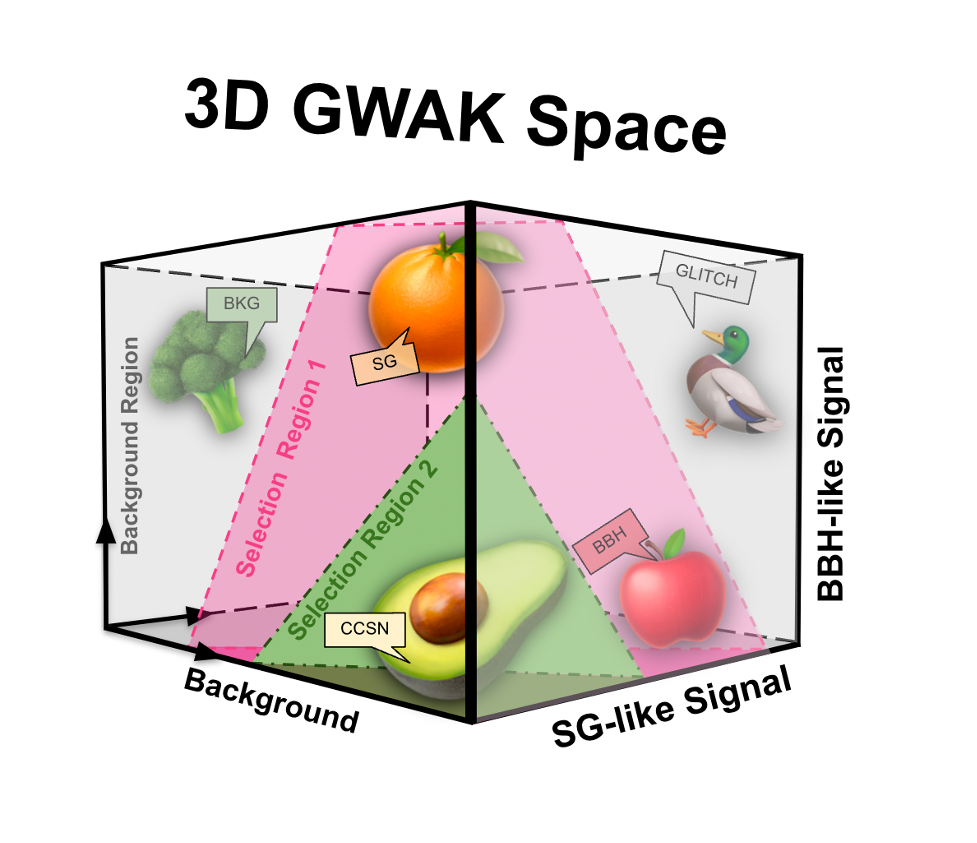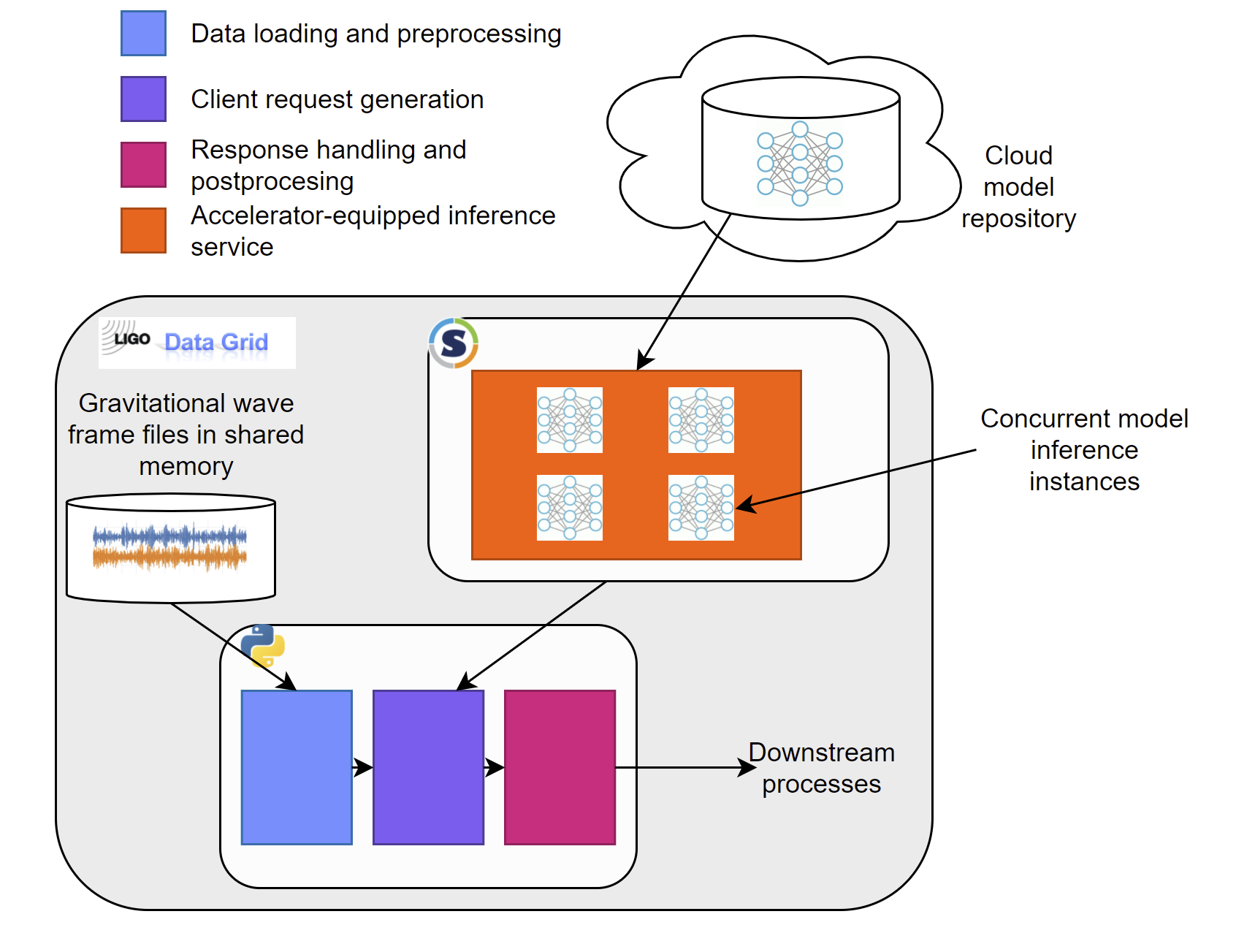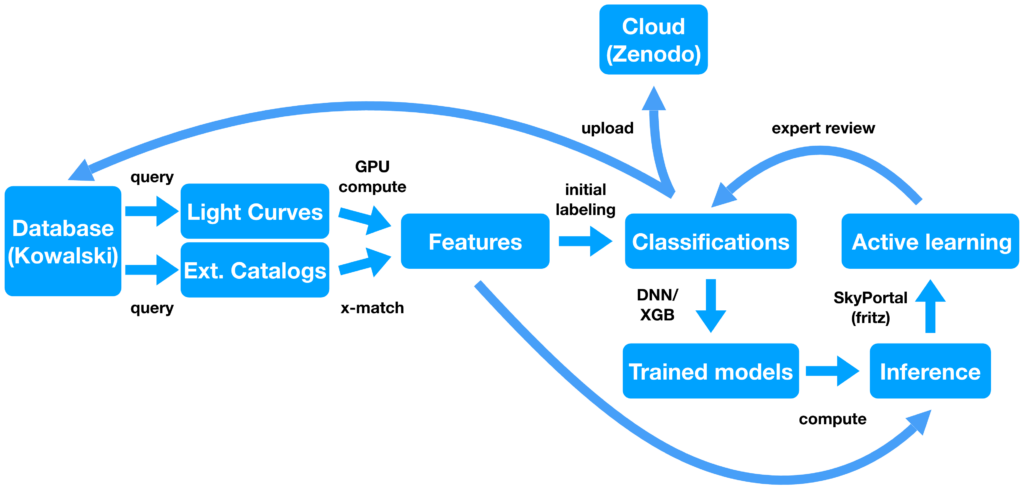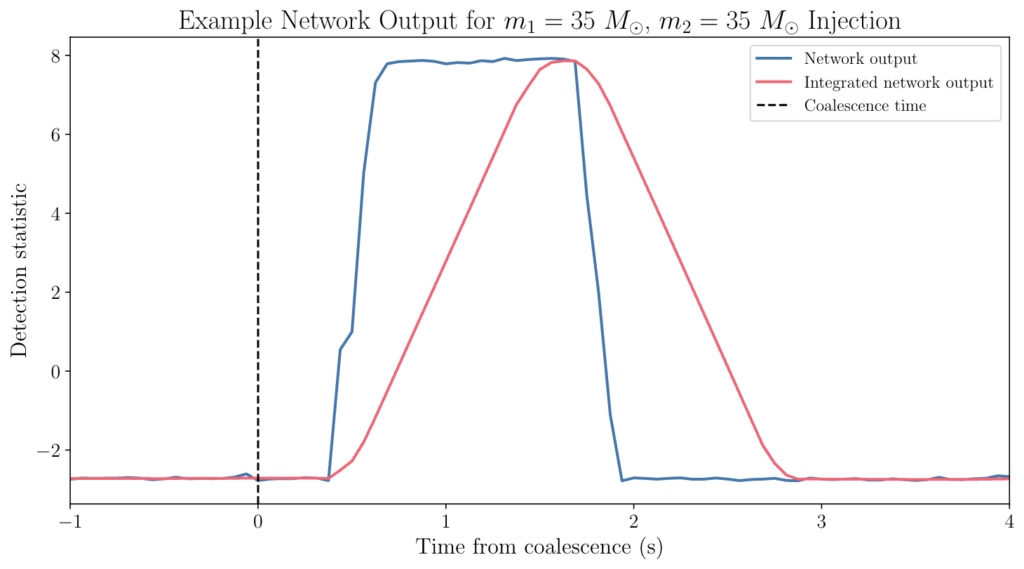Multi-messenger Astrophysics
The Multi-Messenger Astrophysics (MMA) develops and deploys software within astronomical facilities to enable discovery.
In particular, we are focused on development to improve and characterize transient source detection(s) by gravitational-wave detectors such as Advanced LIGO, Virgo and KAGRA. Associated with such transient source detections/candidates, we are contributing to the preparations for the follow-up by optical facilities such as the Zwicky Transient Facility of these events, which began May 2023. An additional direction is development of low-latency triggering and pointing algorithms for supernova burst neutrino direction, in the context of DUNE, the SuperNova Early Warning System as well as reconstruction algorithms in IceCube.
Projects

Gravitational-Wave Anomalous Knowledge with Recurrent Autoencoders.
The goal of this project is to leverage machine learning for the detection of gravitational waves originating from sources other than compact binary coalescences. Motivated by the current dominance of compact binary coalescence searches within the algorithmic landscape, we seek to develop robust algorithms capable of identifying signals from more challenging or unknown sources, aiming to unveil novel phenomena and contribute to our understanding of new physics. GWAK uses a deep recurrent autoencoder-based model specifically designed for detecting non-compact binary coalescence models. Adopting a semi-supervised approach enables the exploration of sources that defy modeling, while also providing valuable information on the resemblance of signals to known sources. The added advantage of fast inference not only facilitates efficient detection but also opens avenues for multi-messenger astronomy, enhancing the project’s significance in the broader context of gravitational wave research.
For more information, please see here.

Gravitational-wave inference as a service prototype.
The goal of this project is to establish a versatile platform capable of deploying real-time machine learning algorithms within the realm of gravitational-wave science. Motivated by the paradigm of inference as a service, we aim to harness existing computing resources efficiently, ensuring real-time capabilities. We have demonstrated sub-second latencies through the implementation of distributed inference in both noise cleaning and compact binary coalescence detection pipelines, specifically tailored for gravitational-wave computing resources. This addresses not only the need for rapid analysis in gravitational-wave science but also signifies a pivotal advancement in the field by showcasing the feasibility of deploying machine learning algorithms with remarkable speed and efficiency.
For more information, please see here.

The Zwicky Transient Facility Source Classification Project
Understanding the ever-changing nature of celestial objects, from stars to galactic centers, is crucial for astrophysics. The Zwicky Transient Facility (ZTF) uses time series observations to track the variability of over a billion sources. Given the immense scale of this data, we employ automated methods to thoroughly analyze it. This project uses neural network and XGBoost machine learning algorithms to categorize ZTF sources into different classes, based on a carefully crafted training set. The classification catalog resulting from this work is accessible to the public, and the software is open-source, ready to adapt for future time-domain surveys.
For more information, please see here.
Machine learning supernova pointing with DUNE.
The goal of this project is to determine the direction of a supernova by analyzing neutrino interactions within the DUNE detector. Utilizing machine learning, the project aims to achieve low-latency and precise evaluation of the supernova’s direction. Neutrinos, being the earliest signals to reach Earth after a core-collapse supernova, provide crucial information well before optical signals from the shock breakout. We are testing 1D convolutional neural networks and graph neutral networks to enhance the existing offline supernova pointing pipeline. The detection of neutrinos in DUNE’s liquid argon time projection chamber will enable the derivation of information for promptly localizing the supernova through multimessenger observations.

aframe: A machine-learning pipeline for real-time detection of gravitational waves from compact binary coalescences
Swiftly detecting gravitational waves is essential to enable timely follow-up observations by telescopes. Neural networks have showcased their ability to understand complex patterns and make rapid decisions with minimal computational resources, making them an appealing choice for detecting gravitational waves. However, integrating these advanced algorithms into the field of gravitational-wave astrophysics has proven to be a challenging task. In this project, we introduce the first-ever fully machine-learning based system designed to swiftly detect gravitational waves from compact binary coalescences with low latency. Our innovative pipeline not only demonstrates near state-of-the-art sensitivity but also achieves this at a fraction of the time and computational cost required by traditional methods like matched filtering pipelines.

Acceleration of ML Inputs for IceCube: IceCube operates in an extreme environment with limited resources, i.e. power. Calibrating and feature extracting the individual channels consumes a significant fraction of the compute resources at the South Pole and is required to generate inputs for the current generations of IceCube machine learning-based algorithms. Accelerating these inputs will allow IceCube to reduce the power requirements for the computing infrastructure and overall time to result.
Facilities

The Deep Underground Neutrino Experiment (DUNE) is a neutrino experiment under construction, with a near detector at Fermilab and a far detector at the Sanford Underground Research Facility that will measure neutrinos from the beam produced at Fermilab. The far detector with its large mass and a rock overburden of about 1.5 km to reduce the cosmic ray flux is also in particularly suited to observe neutrinos from astrophysical sources such as core collapse supernovae. The DUNE detector is a time-projection chamber with an excellent 3D imaging reconstruction capability highly suitable for a direction reconstruction of supernova neutrinos. Ionization energy and scintillation light information are used for particle reconstruction. The DUNE can observe electron neutrino charge current interactions, which makes it complementary to other large neutrino observatories such as HyperK or JUNO.
Image Credit: CERN
LIGO, the Laser Interferometer Gravitational-Wave Observatory, are kilometer scale interferometers designed to detect ripples in space-time, otherwise known as gravitational waves. Caused by the most energetic events in the cosmos, such as the collision of black holes or the explosion of massive stars, LIGO uses powerful laser beams bouncing between mirrors to sense the stretching and squeezing of spacetime caused by these cosmic events. When gravitational waves pass through Earth, LIGO can catch these gravitational waves, giving us a completely new way to explore the otherwise unseen corners of the universe. Along with international counterparts Virgo in Italy and KAGRA in Japan, the International Gravitational-wave Network (IGWN) is discovering some of the Universe’s most interesting phenomena.
Image Credit: Caltech/MIT/LIGO Lab


The IceCube Neutrino Observatory (or simply IceCube) is a neutrino observatory located at the Amundsen–Scott South Pole Station in Antarctica. It was completed in Dec 2010 and has been operating continuously since. IceCube is
the world’s premier facility to detect neutrinos with energies above
approximately 10 GeV by instrumenting over a gigaton of polar ice with 5,160 optical sensors. The sensors are buried between 1,450 and 2,450 meters below the surface of the South Pole ice sheet in a hexagonal grid.
Image Credit: IceCube Neutrino Observatory/NSF
The Zwicky Transient Facility (ZTF) is an optical sky survey, constantly scanning the night sky to capture the unexpected and dynamic moments in the cosmos. Acting as a high-tech celestial camera, ZTF’s 50 square degree camera observes the sky repeatedly, creating a vast celestial map that records changes in the night sky over time. From exploding stars to elusive asteroids, ZTF’s mission is to catch these fleeting events, or “transients,” in action. Named after pioneering astronomer Fritz Zwicky, this cutting-edge facility helps scientists uncover the mysteries of our universe, contributing to a deeper understanding of the dynamic and ever-evolving nature of the cosmos.
Image Credit: Palomar Observatory/Caltech

